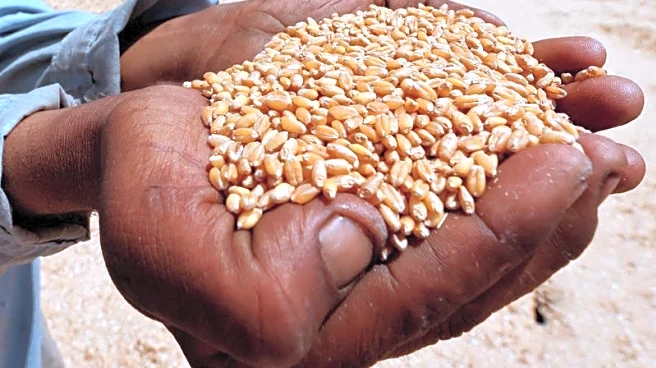What's Happening?
The Food and Agriculture Organization of the United Nations (FAO) has reported a slight decline in the global food commodity prices for September. The FAO Food Price Index, which monitors monthly changes in international prices of globally-traded food commodities, averaged 128.8 points in September, down from 129.7 points in August. This represents a 3.4 percent increase from the previous year. The decline was primarily driven by drops in sugar and dairy price indices. The FAO Cereal Price Index fell by 0.6 percent due to decreased international wheat prices, which have been declining for three consecutive months. This trend is attributed to subdued international demand and large harvests in key producing countries. Additionally, world maize prices dropped amid forecasts of abundant supplies and the temporary suspension of grain export taxes in Argentina.
Why It's Important?
The slight decline in global food prices is significant as it reflects the complex dynamics of international commodity markets. Lower food prices can alleviate pressure on consumers worldwide, particularly in developing countries where food costs constitute a large portion of household expenses. However, the increase in meat prices, driven by strong demand in the United States, highlights ongoing supply challenges. The mixed trends in commodity prices underscore the importance of monitoring agricultural production and trade policies, which can have far-reaching impacts on food security and economic stability. The FAO's report provides valuable insights for policymakers and stakeholders in the agriculture sector, helping them to anticipate market shifts and adjust strategies accordingly.
What's Next?
The FAO has released updated forecasts for global cereal production, predicting a 3.8 percent increase in total output for 2025, marking the largest annual growth since 2013. This is expected to lead to higher cereal utilization and stocks, with global cereal stocks potentially reaching 900.2 million tonnes by the end of the 2026 season. The anticipated growth in cereal production and trade could stabilize food prices further, although fluctuations in demand and supply dynamics remain a concern. Stakeholders in the agriculture sector will need to closely monitor these trends to ensure food security and manage economic impacts effectively.
Beyond the Headlines
The FAO's report also highlights the potential for increased international cereal trade, driven by notable growth in wheat trade. However, international rice trade is expected to decline due to lower demand from Asian and African countries, reflecting good local harvests. This shift in trade patterns could influence global food distribution and pricing strategies. Additionally, the report features a review of prospects for low-carbon ammonia production for fertilizers, indicating a growing interest in sustainable agricultural practices.











